North Dakota has revised its definition of compassionate end-of-life care visits as the state begins to relax restrictions as to who can access nursing homes and assisted living facilities.
Since implementing the restrictions in March as the pandemic ramped up, North Dakota exempted hospice providers and other end-of-life care clinicians from rules limiting access, but the new definition expands the types of individuals who can continue to access those facilities.
“Our knowledge about the coronavirus and data on its local impact across our state continues to grow,” said North Dakota Department of Human Services Executive Director Chris Jones. “We appreciate the opportunity to work with the Task Force on Reuniting Residents and Families, the North Dakota Long-Term Care Ombudsman and our colleagues in the North Dakota Department of Health to develop common sense guidelines that reflect new information and are responsive to the needs of individuals and their families.”
Under the new definition, the term used by the state, “compassionate end-of-life care visitation,” now can include social visits for skilled nursing or assisted living residents who are showing signs or symptoms of psychosocial or medical decline due to isolation that are above and beyond normal parameters.
The expanded definition aligns with recent guidance to states from the U.S. Centers for Medicare and Medicaid Services (CMS).
The revised state guidelines indicate that these scenarios are only permissible on a very limited basis and should not be considered routine. The decision to allow such visits would rest with the resident’s clinical interdisciplinary team. Facilities must report such cases to the state’s Vulnerable Population (VP3) Task Force.
Nursing homes in particular have been ravaged during the pandemic. More than 111,000 confirmed COVID-19 cases to date have occurred among residents of skilled nursing facilities, in addition to more than 76,000 suspected cases, according to the U.S. Centers for Medicare & Medicaid Services (CMS). These infections have led to more than 30,000 deaths.
More than half of hospice provider respondents to a Hospice News reader survey indicated that they believed their organizations would benefit from the states’ “reopening,” compared to 30% of respondents who said it would have a negative impact. Slightly less than 20% felt the removal of restrictions would not impact their clinical or business operations at all. A key factor in these results was the expectation that it would become easier for hospices to access patients receiving care in nursing homes or assisted living facilities.



